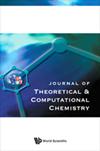两种咪唑-查尔酮杂化配体及其Pd, Pt和Zn配合物的电荷输运和非线性光学(NLO)性质的量子化学筛选:DFT研究
IF 2.4
Q3 Computer Science
引用次数: 4
摘要
利用色散校正密度泛函理论(DFT- d3)和时间依赖DFT (TD-DFT)方法,对2-[1-(3-(1h -咪唑-1-基)丙基)-3-(苯丙烯基)]苯酚和2-[1-(3-(1h -咪唑-1-基)丙基)-3-4-硝基苯丙烯基]苯酚及其Pd、Pt和Zn螯合物进行了量子化学筛选,研究了它们的电荷输运和非线性光学(NLO)性质。从我们的结果来看,Pd和Pt配合物由于其非常小的重组能而表现出优异的空穴输运性质。HL1-Pt配合物的光提取效率特别高,因此适合于制造紫光发光二极管(led)中的空穴传输层。此外,氧化还原电位和化学稳定性研究使我们能够验证HL2配合物与它们的HL1对应物相比,在水分(氧化)方面具有更大的稳定性。除锌配合物外,在所得到的配合物中确定的金属电荷转移电子跃迁。本文章由计算机程序翻译,如有差异,请以英文原文为准。
A Quantum Chemical Screening of Two Imidazole-Chalcone Hybrid Ligands and Their Pd, Pt and Zn Complexes for Charge Transport and Nonlinear Optical (NLO) Properties: A DFT Study
A quantum chemical screening of two imidazole-based chalcone ligands: 2-[1-(3-(1H-imidazol-1-yl)propylimino)-3-(phenylallyl)]phenol and 2-[1-(3-(1H-imidazol-1-yl)propylimino)-3-4-nitrophenylallyl]phenol (hereinafter referred to as HL1 and HL2 respectively) and their Pd, Pt and Zn chelates for charge transport and nonlinear optical (NLO) properties, is reported via dispersion-corrected density functional theory (DFT-D3) and time-dependent DFT (TD-DFT) methods. From our results, Pd and Pt complexes have been observed to show excellent hole-transport properties, owing to their very small reorganization energies. The light extraction efficiency of the HL1-Pt complex was deduced to be particularly impressive, thus suitable for the manufacture of hole transport layer in violet light emitting diodes (LEDs). Moreover, redox potentials and chemical stability studies have enabled us to validate the greater stability in moisture (towards oxidation), of HL2 complexes compared to their HL1 counterparts. metal charge transfer electronic transitions identified in the resulting complexes with the exception of the zinc complexes.
求助全文
通过发布文献求助,成功后即可免费获取论文全文。
去求助
来源期刊
CiteScore
1.70
自引率
0.00%
发文量
0
审稿时长
3 months
期刊介绍:
The Journal of Theoretical and Computational Chemistry (JTCC) is an international interdisciplinary journal aimed at providing comprehensive coverage on the latest developments and applications of research in the ever-expanding field of theoretical and computational chemistry.
JTCC publishes regular articles and reviews on new methodology, software, web server and database developments. The applications of existing theoretical and computational methods which produce significant new insights into important problems are also welcomed. Papers reporting joint computational and experimental investigations are encouraged. The journal will not consider manuscripts reporting straightforward calculations of the properties of molecules with existing software packages without addressing a significant scientific problem.
Areas covered by the journal include molecular dynamics, computer-aided molecular design, modeling effects of mutation on stability and dynamics of macromolecules, quantum mechanics, statistical mechanics and other related topics.

 求助内容:
求助内容: 应助结果提醒方式:
应助结果提醒方式:


